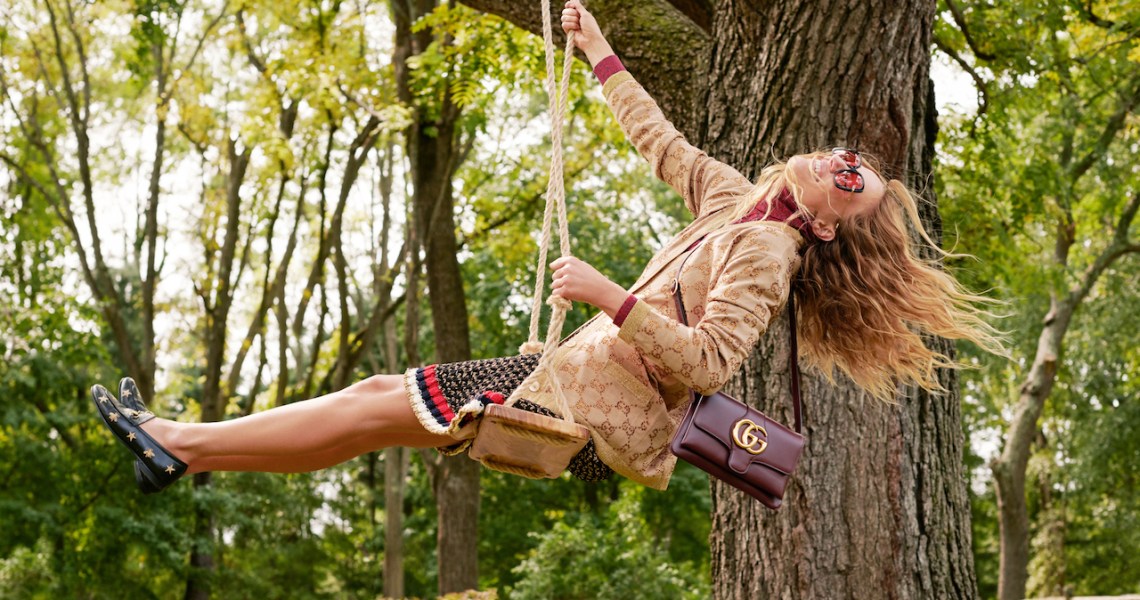TikTok has swiftly become brands’ go-to social channel for connecting with younger consumers — and luxury brands have joined that pool in recent months.
Moncler, for example, rolled out a hashtag-challenge campaign on December 14. It featured influencer Charli D’Amelio, the most followed person on TikTok, along with other big names like Bella Poarch, Michael Le and Abby Roberts. Called the #MonclerBubbleUp challenge, it asked users to wrap themselves in something resembling Moncler’s puffy, bubbly winter coats — choices included sleeping bags and bubble wrap. They then used TikTok’s editing features to transition it into an actual Moncler coat. While sponsored hashtag challenges like this can be expensive — as much as $150,000 per week — they can also be worth it. As of Dec. 18, Moncler said the hashtag had already received more than 2 billion views.
Other luxury brands including Louis Vuitton, Fendi, Balenciaga, Dior, Stella McCartney and Gucci have joined TikTok this year, but more often than not, they’ve failed to be embraced by daily users. Fendi has around 57,000 followers and Balenciaga has 84,000, while fast-fashion brand Fashion Nova has more than 2 million followers.
@dior‘Pink is the color of happiness’ – Christian Dior ##diormakeup♬ original sound – Dior
A main reason for luxury’s lagging behind: The natural strengths of the platform lay far outside of their usual experience. Luxury content tends to be slick, highly produced and tightly controlled. Dior, for example, frequently posts small snippets of marketing campaigns that premiered elsewhere and were not designed for TikTok. In contrast, Fashion Nova’s posts are typically reposts of follower videos and casual videos on how to style clothes.
@fashionnovaWhich for are you feeling? Find the full outfit deets on our Insta 💕 ##fashionnova ##ootd♬ original sound – FashionNova
The most effective campaigns on TikTok tend to be informal, organic and fun, according to CeCe Vu, fashion and beauty partnerships lead at TikTok. She suggests brands let users lead the conversation and focus on informal things like educational videos and humor.
“The ideal campaign on TikTok is more authentic, creative, community-driven and less aspirational than you might see on another platform,” Vu said. “Things that are less produced that can show off their personality in a unique way play very well, as does educational stuff like in beauty.”
Brands including Burberry and Prada have made TikTok accounts but post on them rarely, sometimes posting only a few videos per month, while fast-fashion brands like Aldo and Blush Mark capture more of the TikTok audience with their more consistent organic campaigns. Pretty Little Things, for example, has posted almost daily on TikTok since 2018 and has more than 1 million followers.
Moncler’s hashtag challenge was successful largely because it tapped existing influencers with a large platform to film their own content; Moncler had minimal control, according to its press release about the challenge. And Louis Vuitton has amassed more than 2 million followers in barely a month on the platform by posting informal behind-the-scenes videos from shoots, which regularly get several million views.
“TikTok stands out among marketers mostly because of its audience and the informal relationship between users and brands,” said Jonathan Treiber, CEO of offer management platform RevTrax, noting that 42% of TikTok users are ages 18-24, while only 22% of Instagram users are in the same bracket. “TikTok is the new kid on the block, and it’s more popular among primarily a younger Gen-Z audience, whereas a platform like Instagram has a much broader appeal and a more traditional brand-user relationship. Brands that want the youngest, most progressive consumers should focus on TikTok and trying to operate on that platform differently than they would elsewhere.”
But just moving away from overly produced campaigns is not enough for luxury brands to gain traction on the platform. For example, Gucci posted a series of six nearly identical videos at the start of December that showed different models performing a similar dance to the same music. It had mixed results: While one of the videos caught on and received more than 300,000 likes, the others fizzled; they had less than 10,000 likes and dozens of comments expressing confusion and, in some cases, derision at Gucci for attempting to seem approachable.
Gucci saw better results when it took the lead from a much more natural TikTok phenomenon. A woman named Morgan Presley started a trend in August where users pretended to be Gucci models by wearing wildly clashing outfits. In September, Gucci tapped Presley to make a video along the same lines, which it hosted on the brand’s TikTok account. It also began reposting (with permission) other videos users had made. These brought in far more engagement than Gucci’s more manufactured attempts to capture the zeitgeist, with one video getting nearly 6 million views.
“That really swept the internet,” Vu said. “Gucci was very delighted with the organic growth that brought and then they continued to build on it. And they did that by bringing in the expertise of the creator here, which was Morgan. That’s absolutely, I think, the right way to do it.”




